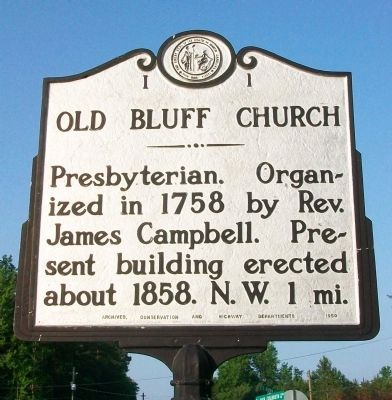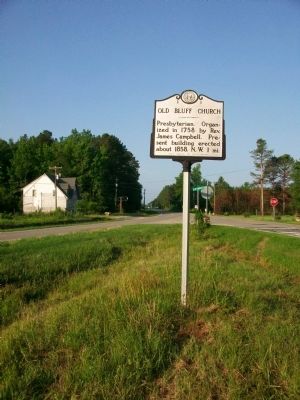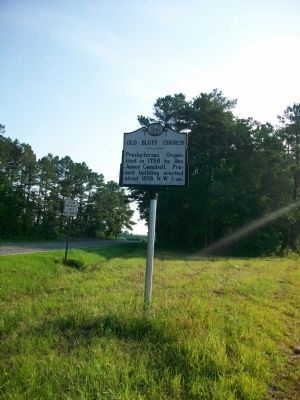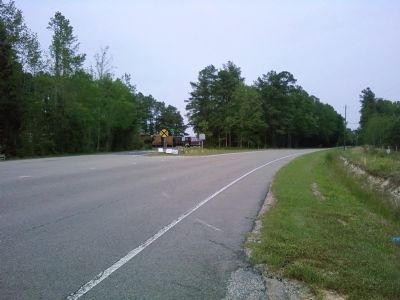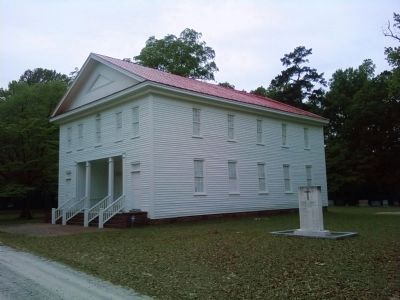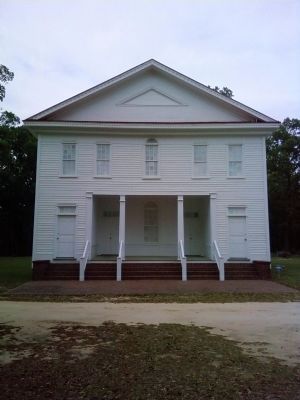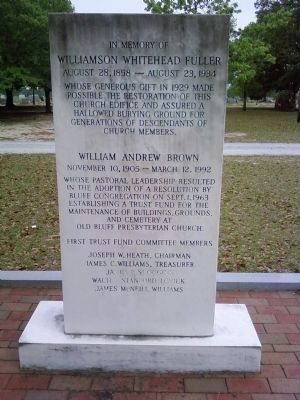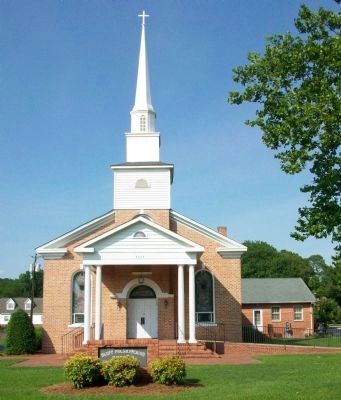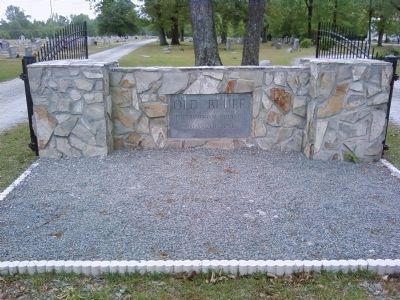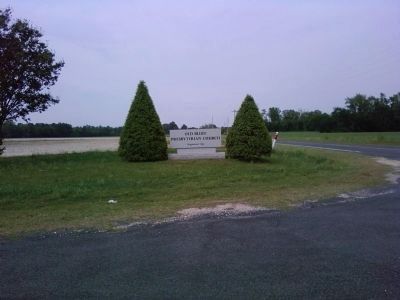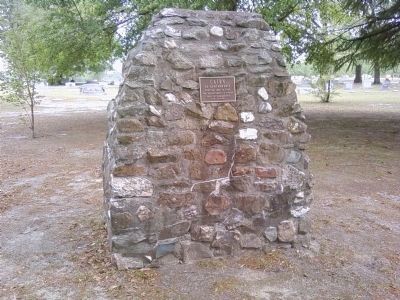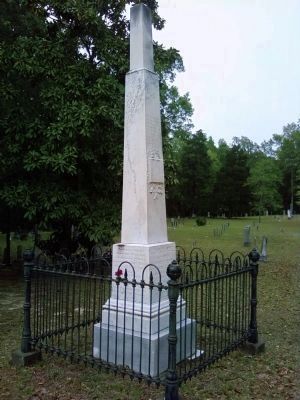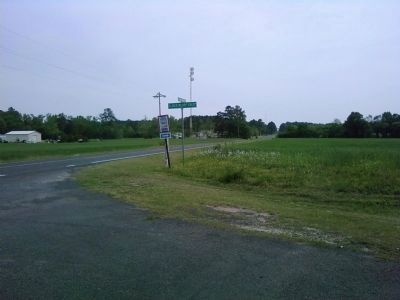Near Godwin in Cumberland County, North Carolina — The American South (South Atlantic)
Old Bluff Church
Erected 1950 by Archives, Conservation and Highway Departments. (Marker Number I-1.)
Topics and series. This historical marker is listed in this topic list: Churches & Religion. In addition, it is included in the North Carolina Division of Archives and History series list. A significant historical year for this entry is 1758.
Location. 35° 10.391′ N, 78° 43.292′ W. Marker is near Godwin, North Carolina, in Cumberland County. Marker is at the intersection of Dunn Road (U.S. 301) and Sisk Culbreth Road, on the left when traveling north on Dunn Road. Marker is about one mile north of the village of Wade. Touch for map. Marker is in this post office area: Godwin NC 28344, United States of America. Touch for directions.
Other nearby markers. At least 8 other markers are within 6 miles of this marker, measured as the crow flies. Colonel Alexander McAllister (approx. 0.8 miles away); a different marker also named Old Bluff Church (approx. 0.8 miles away); David M. Williams (approx. 3.8 miles away); Prelude to Averasboro (approx. 4.8 miles away); Battle of Averasboro (approx. 4.8 miles away); Federal Hospital (approx. 4.8 miles away); Federal Artillery (approx. 5.6 miles away); "Oak Grove" (approx. 5.7 miles away).
Regarding Old Bluff Church. This marker identifies the first of three structures for the Old Bluff church. This is near the location where Rev. Campbell formed its first congregation in 1758. The third church, built in 1858, is located at the end of Old Bluff Church Road about a mile north off Sisk Culbreth Road. Although this building still stands, it is no longer used as the church. The present church is in the village of Wade, 1/4 mile east of the railroad tracks.
Also see . . .
1. Scots around the world: History of the Old Bluff Presbyterian Church. (Submitted on June 6, 2010, by Cleo Robertson of Fort Lauderdale, Florida.)
2. USGenWeb: Old Bluff Presbyterian Church History. (Submitted on June 6, 2010, by Cleo Robertson of Fort Lauderdale, Florida.)
Additional commentary.
1. Old Bluff Church
Reverend James Campbell, who was born in Campbelltown, Kintyre, Scotland about 1705, came to America about 1730. He came to North Carolina from the Presbytery of Philadelphia about 1757 and settled on a tarct of two hundred acres on the west side of the Cape Fear River opposite to where the Old Buff Presbyterian Church now stands. Reverend Campbell commenced his preaching among the Scots, in both Gaelic and English, in three locations: at the home of Roger McNeill, near Tranthams Creek, at the home of Archibald McKay on the Long Street (the Yadkin Road), and at John Dobbin’s Ordinary on Barbecue Creek.
The Presbyterian Church in the Upper Cape Valley was organized on October 18, 1758, with the signing of a contract with Reverend Campbell by “Presbyterian Gentlemen” Hector (called “Bluff” Hector) McNeil, Gilbert Clark, Thomas Gibson, Alexander McAlister, Malcom Smith, Archibald McKay, John Patterson, Dushie Shaw, Neil McNeill, Archibald Buie, Angus Culbreth, and John McPherson for “the sum of 100 pounds in good & lawful money of North Carolina . . . yearly.” Although the call was effective from June 22, 1758, Reverend Campbell was not (legally) allowed to preach or perform marriages until January 18, 1759 when he subscribed to the required oath that he would not oppose the doctrine, discipline, and liturgy of the Anglican Church of England.
Neill McNeill (and his wife Catharine) by deed of February 18, 1761, conveyed to Hector McNeill and Alexander McAlister, members of the original Session and both residing on the east side of the Cape Fear River, “one acre of land whereon is built and erected a Meeting House as the same now stands” on the west side of the Cape Fear River near Tranthams Creek close to the home of Roger McNeill, son of Neill McNeill. Called Roger’s Meeting House, this building was probably a small log structure
built about 1759 and the first church building in the Upper Cape Fear Valley.
Reverend Campbell served the three churches, now represented by Bluff, Longstreet, and Barbecue Presbyterian Churches, assisted in the Barbecue area from 1770 by Reverend John MacLeod, until about 1776 when, threatened about his prayers supporting the Patriot Cause, he moved to Guilford County. In 1780, Reverend Campbell returned to his home on the west bank of the Cape Fear River, where he died and was buried in a family graveyard.
Buff Church still preserves two Communion Goblets with the inscription, “For the Presbyterian Congregations in Cumberland County, under the care of the Rev’d John MacLeod, Apr. 21st 1775.”
Sometime after 1780, a new meeting house, probably also a log structure, was built on the east side of the river. Apparently both meeting houses were used until about 1785 when a frame building was built on the bluff at the east side of the river. On July 23, 1791, John MacNeill conveyed to Farquard Campbell and Alexander McAlester, as trustees of the Bluff Meeting House, two acres near the burying ground “part of 200 acres possessed by sd. MacNeill known by the name of the Bluff where said piece of land with the Meeting House now standing on the same. . . .” this frame building was repaired in 1816, the subscription list totaling $112,
and used until about 1855, when the present Bluff Church was built.
Reverend Dugald Crawford, who began his ministry in North Carolina in 1783, came from time to time to preach at the Bluff until he was called as pastor in 1786. He served until about 1793 when he was followed by the newly immigrated Reverend Angus McDiarmid who served until 1803. The Bluff was supplied by Reverend Murdock Murphy until November 1810 when Reverend Allan McDougald took over as a regular supply. Reverend McDougald received a regular call on April 2, 1812, to serve Bluff, Barbecue, and Averasboro in the new Fayetteville Presbytery. He was followed about 1844 by Reverend Evander McNair who served until 1855 except for a short period when he was relieved by the Reverend Simeon Colton. Reverend Duncan D. McBryde served from 1855 to 1890, Reverend Joseph B. Mack from 1890 to 1891, and the Reverend George A. Hough from 1891 to 1892.
In 1892, a group of forty-one Bluff Church members attending a mission chapel begun by Reverend McBryde organized and moved their memberships to Macmillan Presbyterian Church, located about four miles to the southeast of the Bluff Church site.
Reverend Andrew Morrison Hassell served as stated supply of the Bluff from October 1893 until October 1894 when he was regularly called as pastor. He served until May 1899 when the Reverend James Stedman Black
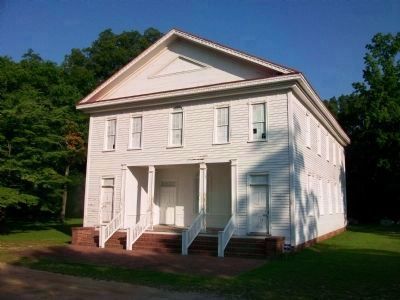
Photographed By Robert Cole, June 6, 2010
5. Old Bluff Church (1858)
Third church built by the congregation in 1858 and used until about the early 1900s, at which time the congregation split and moved to two new locations, in Godwin (to the north) in 1903 and in Wade Station (to the south) in 1909. The building continued to be used as a meeting hall, deteriorated for the next two decades, restored in 1929 and again in 2002, and has continued to be maintained by the new Bluff Church in Wade. Actual location of the building and its cemetery is about a mile north of the historical marker.
On August 16, 1903, the congregation met to consider moving the place of worship to a more accessible location. They voted 31 to 11 to move the church to Godwin where a Sabbath School had been begun in 1889 and where the manse was located. Objections from the church members living in the Wade area resulted in a split, the members from Wade keeping the Bluff Church and one hundred members from the Godwin area organizing and moving their memberships to the Godwin Presbyterian Church in May 1904.
Under the leadership of Reverend Letcher Smith who served the Bluff form 1904 to 1906, a new frame church was begun at “Wade Station.” Under the guidance of Reverend Angus R. McQueen, who replaced Reverend Smith in 1907, the move was made on October 18, 1908, one hundred and fifty years to the day after the call to Reverend James Campbell.
The Old Bluff Church building, left in disuse to watch over the cemetery, was deteriorating when, in 1929, Mr. W. W. Fuller, a former Chief Counsel of the American Tobacco Company of New York, paid to restore the church, both inside and out, to reflect properly its prominent place in history. The Old Bluff Presbyterian Church Trust Fund continues the maintenance and improvement of the building, grounds, and cemetery.
— Submitted June 12, 2010, by Cleo Robertson of Fort Lauderdale, Florida.
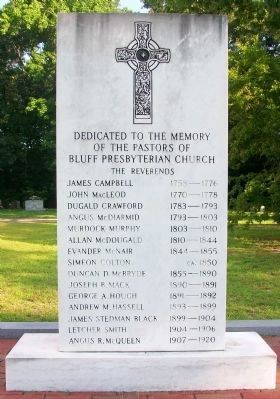
Photographed By Robert Cole, June 6, 2010
8. The Reverends
Dedicated to the memory of the Pastors of Bluff Presbyterian Church:
James Campbell 1758-1776
John MacLeod 1770-1778
Dugald Crawford 1783-1793
Angus McDiarmid 1793-1803
Murdock Murphy 1803-1810
Allen McDougald 1810-1844
Evander McNair 1844-1855
Simeon Colton ca. 1850
Duncan D. McBryde 1855-1890
Joseph B. Mack 1890-1891
George A. Hough 1891-1892
Andrew M. Massell 1893-1899
James Stedman Black 1899-1904
Letcher Smith 1904-1906
Angus R. McQueen 1907-1920
James Campbell 1758-1776
John MacLeod 1770-1778
Dugald Crawford 1783-1793
Angus McDiarmid 1793-1803
Murdock Murphy 1803-1810
Allen McDougald 1810-1844
Evander McNair 1844-1855
Simeon Colton ca. 1850
Duncan D. McBryde 1855-1890
Joseph B. Mack 1890-1891
George A. Hough 1891-1892
Andrew M. Massell 1893-1899
James Stedman Black 1899-1904
Letcher Smith 1904-1906
Angus R. McQueen 1907-1920
Credits. This page was last revised on December 4, 2022. It was originally submitted on June 6, 2010, by Cleo Robertson of Fort Lauderdale, Florida. This page has been viewed 2,174 times since then and 25 times this year. Last updated on December 2, 2022, by Michael Buckner of Durham, North Carolina. Photos: 1, 2, 3. submitted on June 6, 2010, by Cleo Robertson of Fort Lauderdale, Florida. 4. submitted on April 26, 2011, by Lee Hattabaugh of Capshaw, Alabama. 5. submitted on June 6, 2010, by Cleo Robertson of Fort Lauderdale, Florida. 6, 7. submitted on April 26, 2011, by Lee Hattabaugh of Capshaw, Alabama. 8. submitted on June 12, 2010, by Cleo Robertson of Fort Lauderdale, Florida. 9. submitted on April 26, 2011, by Lee Hattabaugh of Capshaw, Alabama. 10. submitted on June 12, 2010, by Cleo Robertson of Fort Lauderdale, Florida. 11, 12, 13, 14, 15. submitted on April 26, 2011, by Lee Hattabaugh of Capshaw, Alabama. • Bernard Fisher was the editor who published this page.
